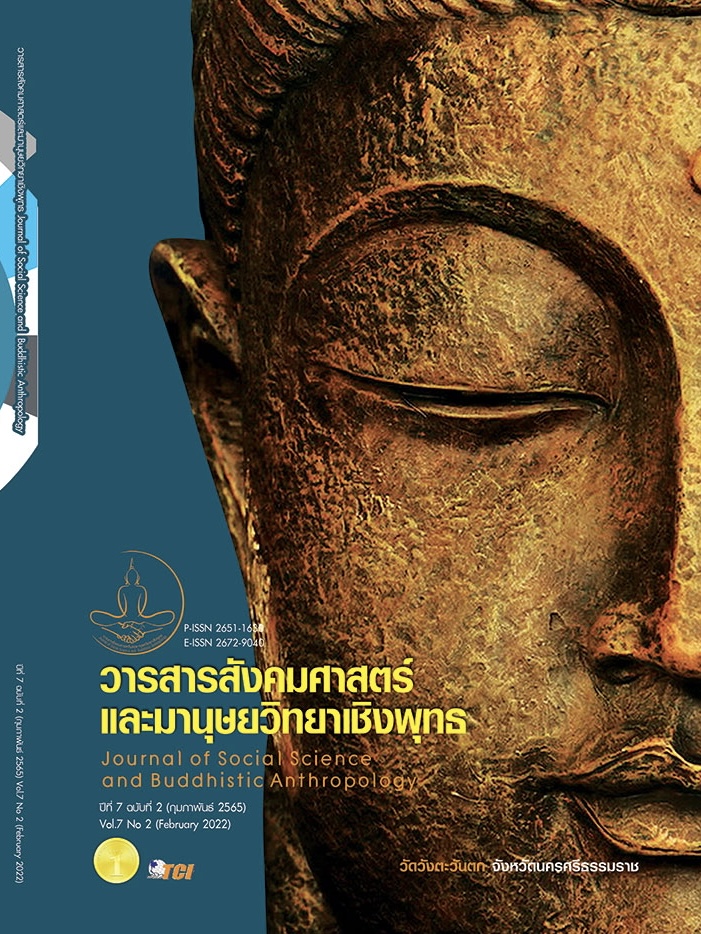A CAUSAL MODEL OF FACTORS INFLUENCING ENTREPRENEURS’ BEHAVIORAL INTENTION TOWARD USING THUNGNGERN APPLICATION IN UDON THANI PROVINCE
Keywords:
Thungngern Application, Perceived Usefulness, Perceived Ease of Use, Perceived Risk, Behavioral IntentionAbstract
The objectives of this research article were to 1) develop a causal model of the factors influencing entrepreneurs’ behavioral intention toward using the Thungngern application in Udon Thani Province 2) study causal factors influencing behavioral intention toward using Thungngern application. This research used the quantitative methods. The samples were collected from 400 entrepreneurs in Udon Thani Province who used the Thungngern application. They were randomized by systematic random sampling. The research’s instrument was a five-level questionnaire. The inferential statistics used were a structural relation analysis by using Covariance-Based Structural Equation Modeling. The findings of the casual relation analysis showed that the latent factors influencing entrepreneurs’ behavioral intention toward using the Thungngern application consisted of perceived usefulness, perceived ease of use, perceived risk variable. For more elaboration. 1) perceived usefulness and perceived ease of use directly positive influenced on entrepreneurs’ behavioral intention. 2) perceived ease of use directly positive influence on perceived usefulness, and 3) perceived risk directly negative influence on entrepreneurs’ behavioral intention and perceived usefulness. Moreover, perceived usefulness mediated the relationship between perceived risk and perceived ease of use to entrepreneurs’ behavioral intention.
References
ข่าวสด. (2564). แม่ค้า คนละครึ่ง โวย! ขายของยาก แถมเงินอีกครึ่งของรัฐโอนให้ไม่ครบ. เรียกใช้เมื่อ 6 กุมภาพันธ์ 2564 จาก https://www.khaosod.co.th/around-thailand/news_5885856
พีพีทีวี ออนไลน์. (2564). เราชนะ คนละครึ่ง ม33 เรารักกัน" กระตุ้นเศรษฐกิจ 2.5 แสนล้านบาท. เรียกใช้เมื่อ 26 มีนาคม 2564 จาก https://www.pptvhd36.com/news/เศรษฐกิจ/144452
สำนักงานปลัดกระทรวงการคลัง. (27 มกราคม 2564). ประชาสัมพันธ์ขอให้ยืนยันตัวตนและใช้จ่ายโครงการคนละครึ่ง. ข่าวกระทรวงการคลัง ฉบับที่ 15/2564, น.1.
สำนักงานเลขาธิการนายกรัฐมนตรี. (2561). มาตรการสวัสดิการแห่งรัฐเพื่อแก้ปัญหาความยากจน. วารสารไทยคู่ฟ้า สำนักงานเลขาธิการนายกรัฐมนตรี, 4(2), 1-44.
Azmi, A. C. & Kamarulzaman, Y. (2012). Perceived Risk and the Adoption of Tax E-Filing. World Applied Sciences Journal, 20(4), 532-539.
Chin, J. & Lin, S. C. (2016). Investigating Users’ Perspectives in Building Energy Management System with an Extension of Technology Acceptance Model: A Case Study in Indonesian Manufacturing Companies. Procedia Computer Science, 72(2015), 31-39.
Dachyar, M. & Liska, B. (2010). Factors influencing purchase intention towards consumer-to-consumer e-commerce. Intangible Capital, 13(5), 948-970.
Davis, F. D. et al. (1989). User Acceptance of Computer Technology: A Comparison of Two Theoretical Models. Management Science, 35(8), 982-1003.
Featherman, M. & Pavlou, P. (2003). Predicting E-Services Adoption: A Perceived Risk Facets Perspective. International Journal of Human-Computer Studies, 59(4), 451-474.
Galib, M. H. et al. (2018). Predicting Consumer Behavior: An Extension of Technology Acceptance Model. International Journal of Marketing Studies, 10(3), 73-90.
Hair Jr., J. F. et al. (2010). Multivariate Data Analysis: A Global Perspective (7th ed.). NY: Pearson Education.
Kamarulzaman, Y. (2007). Adoption of travel e-shopping in the UK. International Journal of Retail & Distribution Management, 35(9), 703-719.
Kim, D. J. et al. (2008). A trust-based consumer decision-making model in electronic commerce: The role of trust, perceived risk, and their antecedents. Decision Support Systems. Research Collection Lee Kong Chian School of Business, 44(2), 544-564.
Kock, N. & Hadaya, P. (2018). Minimum sample size estimation in PLS-SEM: The inverse square root and gamma-exponential methods: Sample size in PLS-based SEM. Information Systems Journal, 28(4), 227-261.
Neda, A. & Saeedeh, R. H. (2017). The effects of perceived risk on social commerce adoption based on the tam model. International Journal of Electronic Commerce Studies, 8(2), 173-196.
Nguyen, T. D. & Nguyen, T. C. (2017). The Role of Perceived Risk on Intention to Use Online Banking in Vietnam. Mangalore, India: ICACCI.
Null, K. D. et al. (2011). The Role of Perceived Risk in Consumer Acceptance of Health-related Technologies (Poster presentation). Seattle, WA: American Pharmacist’s Association Annual Meeting.
Yamane, T. (1973). Statistics: an introductory analysis. NY: Harper. & Row.
Downloads
Published
How to Cite
Issue
Section
License
Copyright (c) 2022 Journal of Social Science and Buddhistic Anthropology

This work is licensed under a Creative Commons Attribution-NonCommercial-NoDerivatives 4.0 International License.








